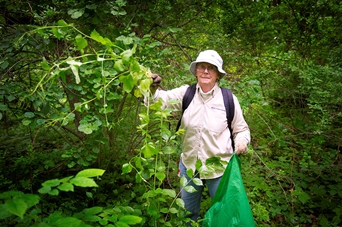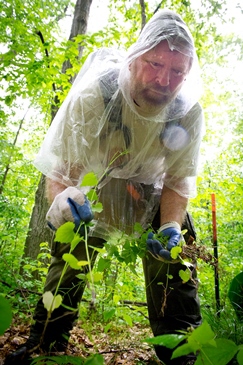Showcasing the DNR: Stewardship volunteers give back to state parks
Michigan Department of Natural Resources sent this bulletin at 06/12/2014 03:58 PM EDT|
Volunteers are critical to the DNR's stewardship mission at state parks. |
 |
 |
 |
 |
 |
Showcasing the DNR
Stewardship volunteers give back to state parks
Sometimes, not finding what you’re looking for is better than actually finding it.
That’s what Charity Steere was thinking as she led a small work group of volunteers through a patch of woods at Waterloo State Recreation Area. The group was looking for garlic mustard, with an eye toward pulling this invasive plant. “This is kind of exciting, really,” said Steere, who has been a volunteer at Department of Natural Resources stewardship work bees at Waterloo since the program began there. “We’ve been pulling garlic mustard here for years and years and I’m not really seeing any.”
“This is kind of exciting, really,” said Steere, who has been a volunteer at Department of Natural Resources stewardship work bees at Waterloo since the program began there. “We’ve been pulling garlic mustard here for years and years and I’m not really seeing any.”
Steere’s excitement was short-lived. Soon she found a plant, then another.
“Whenever you find one, you just want to stand still for a minute and, all of a sudden, they start to pop out to you,” she said.
Native to Europe and part of Asia, garlic mustard was introduced to the United States as an herb. The plant produces a chemical that suppresses the growth of other species and has become the dominant understory in some woodlots. The insects and fungi that keep garlic mustard under control in its native habitats are not present in North America.
“The idea is to get as many of the seeds into the bag as possible,” she said “They produce thousands of seeds, which remain viable for years.”
Steere was participating in her fourth search-and-destroy mission of the season, the third she’s led. After dividing the volunteers into crews, she selected three first-time volunteers to join her crew.
Mike and Linda Vanderlaan, from Plymouth, and their son Nick toted plastic bags through the woods to collect the plants.
“We like to hike,” Linda explained. “We read about this on the DNR website and said, ‘Cool, we can do this.’”
Linda, who works at the library in Plymouth, said she took the day off to participate in the event. They had no problem convincing their son, who will be a senior at Michigan State University, to join them.
“I’m really interested in conservation efforts and I’m concerned about invasive species,” he said. “I want to do my small part in controlling these unnatural developments that harm the ecosystem.”
Steere appointed Danny Massengale to head up another crew at another site about a mile down the road. Massengale is a volunteer extraordinaire; he’s logged more than 1,500 hours at various state parks and recreation areas on a number of stewardship projects.
“I do a lot of volunteering because I enjoy spending time in the woods and helping out,” said the retired builder who lives in Chelsea. Massengale read in the newspaper that volunteers were needed to collect native prairie grass seeds at Waterloo, so he attended and was soon hooked on the activity.
“I enjoyed doing it, so I went back again,” he said. “And again. And again.”
Three years ago, Massengale decided to volunteer at every area that had a stewardship program in southeast Michigan. When he accomplished that goal, he did the same on the southwest side of the state. Among Massengale’s crew were Mike and Karen Ryan from Ann Arbor, who volunteer four or five times a year at county and township parks, and who were at Waterloo picking garlic mustard for the first time.
“We’re retired and we’ve finally got the time to do these kinds of things,” Karen said. “We love the outdoors, and anything we can do to preserve the environment is good.”
Laurel Malvitz-Draper, southeast Michigan steward for the DNR’s Parks and Recreation Division, said having volunteers like Massengale allows the DNR to make a lot of progress. “Danny’s dedicated,” she said. “Very, very dedicated.”
“Danny’s dedicated,” she said. “Very, very dedicated.”
Massengale – like Steere – is one of about a dozen stewardship volunteers with the experience to lead work groups, Malvitz-Draper said. That’s important because she can’t possibly do them all herself.
“We’re focusing on the nine parks and recreation areas that have the highest-quality habitat,” she said. “But there are plenty more in southeast Michigan that could use some additional help. There’s just a limit to how much we can do.”
Malvitz-Draper has been on the job for nine years and most recently began leading stewardship events at Belle Isle, Michigan’s newest state park. The work there is similar to that in other state parks – removing invasive plants and collecting seed from native plants for additional plantings.
“With Belle Isle, we have a lot of great opportunities to expand,” said Malvitz-Draper.
For Steere, who lives within the boundaries of the Waterloo area, there’s no reason to go elsewhere. She’s involved with the local land conservancy and loves the area.
“The longer you live here, the more you realize that this area is very special and very worthy of care and protection,” said Steere. “It’s just a really cool area – it’s geologically unique, supporting endangered species and unusual habitats.”
A horsewoman, who has ridden at Waterloo in the past, Steele said the garlic mustard eradication has gotten her attention, though she participates in spotted knapweed eradication in the summer months and autumn olive and buckthorn cutting in the winter.
“I guess this is my way of doing penance,” she said. “Horses spread this stuff. This isn’t hard work. I think it’s fun -- and every once in a while, you see something that’s just amazing.”
Steere said she’ll probably put in about 10 days volunteering at Waterloo this year.
“We’ve been out here picking garlic mustard in snow storms,” she said. “That’s demented.”
But it’s the kind of demented that helps the DNR with its goal of stewarding the state’s natural resources.
For more information on the volunteer stewardship program – including a calendar of upcoming workdays at state parks and recreation areas – visit www.michigan.gov/dnrvolunteers.
# # #
Note to editors: Photos to accompany this story are available for download at www.michigandnr.com/ftp/OutReach/ in the folder marked Mustard Pull.
**Credit photo: Michigan DNR
Captions:
DSK 501 103.jpg – Volunteer Charity Steere has been attending DNR garlic mustard removal work bees since the program began at Waterloo Recreation Area. She now leads volunteer groups, teaching others how to help manage the invasive species.
DSK 501 114.jpg – Come rain, wind or snow, DNR volunteers like Danny Massengale brave the elements to remove invasive species, and have fun doing it.
DSK501 117.jpg – Invasive species never rest, and neither do the volunteers who help eradicate them. Karen Ryan and Danny Massengale scour the DNR’s Waterloo Recreation Area, looking for garlic mustard to remove from the park.
DSK 501 123.jpg – Removing garlic mustard with the DNR means getting your hands dirty, but it’s also a great opportunity to get some exercise, enjoy the fresh air and socialize with other outdoor enthusiasts.
June 12, 2014 – This story has a word count of 945.
Showcasing the DNR was originally designed for weekly news publications, but we invite everyone to share these stories with friends, family and anyone who would like to learn more about Michigan’s great outdoors and cultural heritage. Media organizations are welcome to cut and paste these stories for use with their own readers and website visitors. Use the Internet link (given above) to access camera-ready photos (in color and/or grayscale) to supplement the story.
Thank you for your interest in Showcasing the DNR. See past editions at www.michigan.gov/dnr-stories. Questions or comments? Please contact DNR public information officer Ed Golder at 517-284-5815 or goldere@michigan.gov.